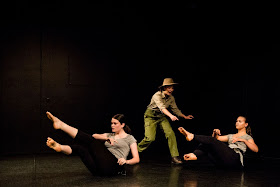Choreographed
by James Batchelor
Performed by
James Batchelor and Amber McCartney
Sound design
by Morgan Hickinbotham
The
Playhouse, Canberra Theatre Centre, 23rd December 2018
Reviewed by
Bill Stephens
At a time
when choreographers are constantly challenged to come up with new movement
styles and arresting images, James Batchelor stands out for the individuality
of his deeply intellectual approach to imagery and movement. His works are
always demanding on his audience, sometimes confounding, occasionally
frustrating, but rarely boring.
Therefore the
opportunity to see how he interpreted his response to a two month voyage in the
Antarctic on the marine research vessel, RV Investigator, was particularly compelling.
 |
| Amber McCartney and James Batchelor performing "Deepspace". |
“Deepspace” was
performed by Batchelor and his long-time collaborator, Amber McCartney, on the
stripped-back stage of the Canberra Playhouse. On entering the auditorium the
audience was directed on to the stage, where they took up positions surrounding
Batchelor and McCartney who were posed motionless, each dressed in black and
holding aloft a white ball.
The two
performers began to move very slowly, in unison and in silence. Their faces remained expressionless
through-out the whole performance. Some movements were repeated constantly, occasionally,
unexpectedly, changing direction, so that audience members had to step out of
the way, to avoid being stepped on.
An ominous creaking soundscape, reminiscent of
the sound of icebergs, was introduced, while the performers continued their
slow, unison movements. Occasionally they would rock from side to side, and it
was easy to imagine the deck of a rolling ship. When they strung two ropes off
some stage rigging, one could imagine the rigging of a ship. But not all their
movements were so easy to interpret, and as they became more obscure, the
audience was left to make what it could of the blank-faced, self-absorbed duo
moving ever-so-slowly, butoh-like, from sequence to sequence.
There was an
engaging sequence where the pace quickened and the duo unexpectedly performed a
deconstructed waltz, and another, late in the performance, during which McCartney stood on Batchelor’s back
while he crawled slowly towards the back wall, where he slowly stood up,
balancing her on his shoulders.
It was at
this point, that this reviewer caught himself wishing that McCartney would do a
backflip off Batchelor’s shoulders, and realised that he had lost interest in trying
to fathom how all this relentlessly slow movement related to a voyage in Antarctica.
McCartney didn’t
do a backflip, but was lowered gently to the floor by Batchelor, where they
formed an impressive cube with their bodies. Despite his admiration for the tenacity
and concentration of the performers, your reviewer decided to succumb to the
protestations of his own body to the discomfort of standing for so long, and find
a seat in the auditorium from which to watch, through the legs of those still
standing, or around those already sitting around the stage, the responses of
the audience to the final sequence, which involved ball-bearings being rolled
from Batchelor’s bare back.
“Deepspace”
may not be Bachelor’s most successful work to date, but as a personal and
studious attempt to seek artistic expression of a significant experience, it is
certainly worth your attention should you get the opportunity to see it.
This review also published in Australian Arts Review. Artsreview.com.au






















